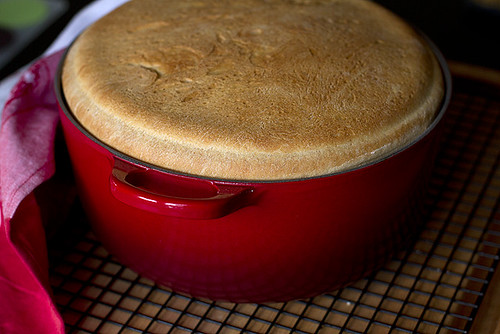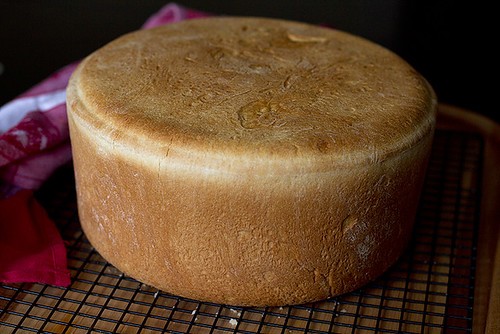NOTE: I’m reposting a few of my favorites from PortlandPeeps onto this blog for safe keeping. This was originally posted in February 2012.
I never tire of the stories my husband shares about his childhood. When he was just ten years old, his father died unexpectedly, leaving his mother with four young children. In spite of the hardships that followed, many of my husband’s fond memories revolve around the delicious homemade foods his mother made. One of those memories was of a shepherd’s bread, and the tradition his family practiced whenever it was served. This slightly sweet bread was baked in a cast iron Dutch oven, leaving circular indentations from its lid on the top crust. Before my mother-in-law served this bread to her family, she gave their loyal border collie the first slice.
When I asked my mother-in-law for this family recipe, she included a 1976 article from Sunset magazine where I learned about its history. Her shepherd’s bread was originally baked by the Basques, people who live in a tiny region that straddles the border of Spain and France.
“Tending their flocks in the remote Western rangelands, Basque sheepmen had to cook for themselves, and they had to make do with a minimum of portable cooking equipment. A Dutch oven became essential for cooking hearty soups and stews — and even for baking bread. They buried the pot in a pit full of hot embers.”
“A poignant camp custom: Before serving, a herder would slash the sign of the cross on top of the loaf, then serve the first piece to his invaluable dog.”
Many years later, some Basques still bake these dome-shaped loaves of bread, but now they do so at home in their conventional ovens. The recipe my mother-in-law used was one that was supplied to Sunset magazine by Anita Mitchell. Anita won the bread-baking championship at the National Basque Festival in 1975.
To make this bread, you’ll need a 10-inch covered Dutch oven (I used my 5.5 quart Le Creuset).
Mixing ingredients for bread dough is so satisfying! If you look closely, you can see bubbles from the yeast mixture working its magic.
This is after the second kneading, and before the dough rises slightly higher than the Dutch oven lid.
This is what the bread should look like when you take it out of the oven. Tap the bread. Does it sound hollow? It’s done!
If you used a cast-iron Dutch oven, you’ll have circles from its lid on the top of your loaf, which would make this even more beautiful!
My favorite part! Bailey got the first slice. She’s so cautious — she sniffed it, licked it, gently took it from my daughter’s hand, then placed it on the porch and looked up at Isabel with those sweet, innocent brown eyes as if asking for permission to eat it.
Here’s the recipe:
Sheepherder’s Bread
Makes 1 very large loaf
3 cups very hot tap water
1/2 cup butter
1/2 cup sugar
2 1/2 teaspoons salt
2 packages active dry yeast
About 9 1/2 cups all-purpose flour
1 Tablespoon vegetable oil
In a large bowl, combine the hot water, butter, sugar and salt. Stir until butter melts. Let cool to warm (110° to 115°F) Stir in yeast, cover and set in a warm place until the mixture is bubbly, about 15 minutes.
Add 5 cups of the flour and beat with a heavy-duty mixer or wooden spoon to form a thick batter. Stir in enough of the remaining flour (about 3 1/2 cups) to form a stiff dough. Turn dough out onto a floured board and knead until smooth, about 10 minutes, adding flour as needed to prevent sticking. Turn dough over in a greased bowl, cover and let rise in a warm place until doubled in size, about 1 1/2 hours.
Punch down dough and knead on a floured board to form a smooth ball. Cut a circle of foil to cover the bottom of the Dutch oven. Grease the inside of the Dutch oven and the underside of the lid with vegetable oil.
Place dough in the pot and cover with the lid. Let rise in a warm place until dough pushes up the lid by about 1/2 inch, about 1 hour (watch closely).
Bake, covered with the lid in a 375° oven for 12 minutes. Remove lid and bake for another 30-35 minutes, or until the loaf is golden brown and sounds hollow when you tap it. Remove from oven and carefully turn loaf out onto a rack to cool.






